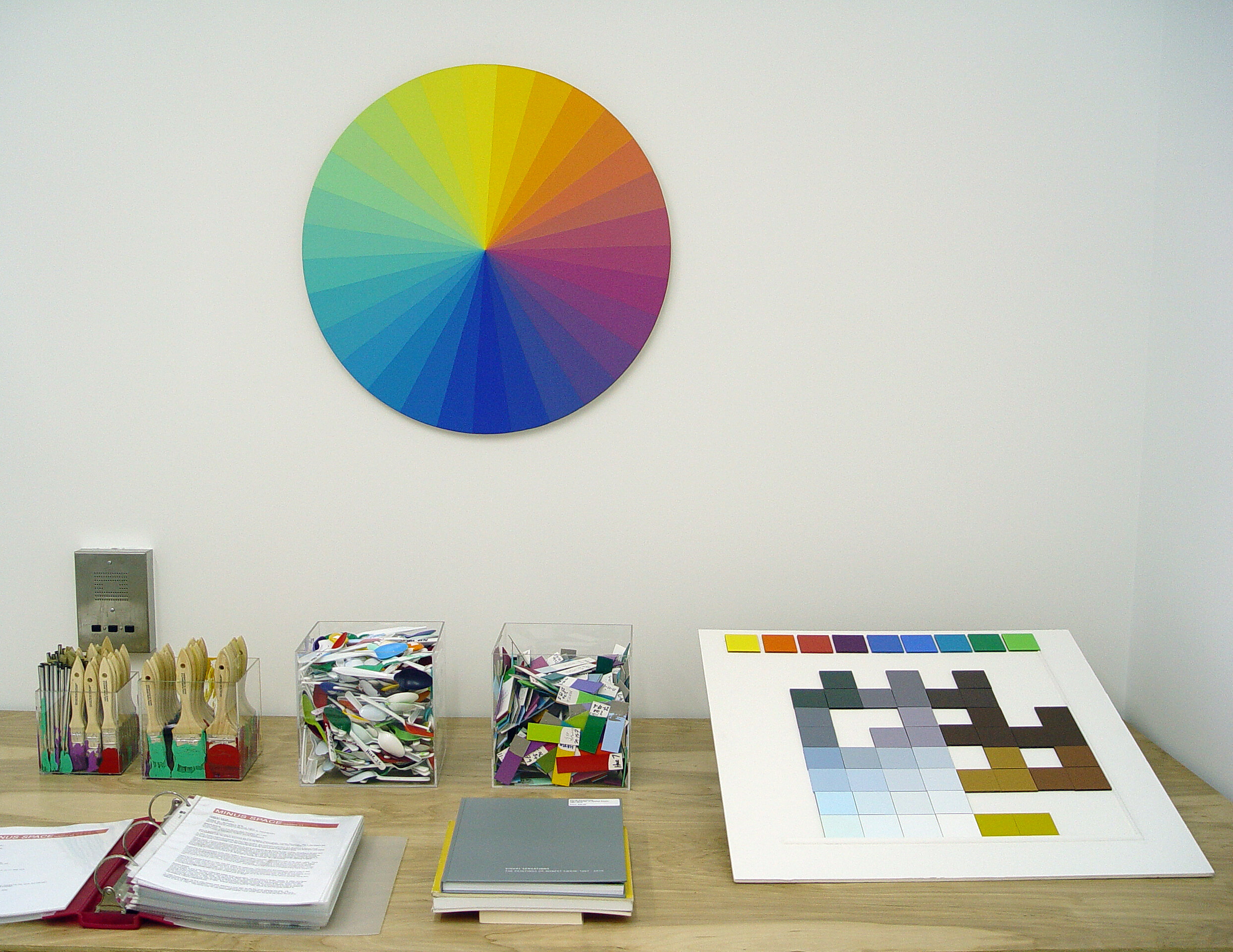
Robert Swain
Primary Research
October 23 - December 4, 2010
Opening: Saturday, October 23, 2010, 3-6pm
MINUS SPACE is honored to announce the solo exhibition Robert Swain: Primary Research. This is the artist’s first solo exhibition with the gallery and it will focus on his life-long investigation into color sensation.
In 1969, Robert began developing his own color system, the centerpiece of which is a 30-part hue (color) circle. When joined with the attributes of value (the lightness or darkness of a color) and saturation (the pureness of a color), his system grew exponentially over the following decades to now include 4,896 distinct parts.
Robert Swain: Primary Research will feature an array of material facets from his color inquiry, including a 30-part hue circle painting, original hand-painted and numbered color charts from the early 1970s, jars of premixed and color-calibrated acrylic paint from his exhaustive paint library, a suite of portfolios containing digital inkjet prints serving as color studies for potential paintings, a set of small brushstroke painting studies, as well as other related ephemera including color chips, mixing spoons, and more. The exhibition will also include two paintings spanning 30 years: a grid painting entitled Untitled 801 (1978, acrylic on canvas, 48 x 48 inches) and a brushstroke painting entitled Untitled 9-25-8 x 13-25-7 x 23-25-6 x 27-25-6 (2010, acrylic on canvas, 36 x 36 inches).
Regarding the development of his color system, Robert states “I became interested in color in the early 1960s. There wasn’t a great deal of written information about it, but I work intuitively. I started to look at color and to make charts and experimental work trying to understand the phenomenology of color. I don’t look at the work as being objective. I simply look at it as a way of trying to get into the subject matter of color and to understand it through experience. And all of this was done visually. It wasn’t done mathematically. It wasn’t done in some kind of progression. It was simply done by painting color charts, looking at them, and deciding in that moment of looking if they were correct or not.”
About his increasing interest in color over the years, he continues, “One thing that fascinates me about color is that each individual color has its own connotation, which can be perceived as emotional or can affect you in some particular way. One of the things I strive for is to try to bring out the uniqueness of color itself as an expressive force. Color is involved with radiant energy. It’s not passive, and in that sense, when you look at color, it’s actually transferring energy into your physical self. One of the things you try to do is isolate some kind of vehicle, some kind of configuration that allows color to speak of itself and for itself.”
Robert Swain
Robert Swain is one of the most influential artists of his generation. He was born in Austin, Texas, in 1940, and grew up in Arlington, Virginia. During high school in the late 1950s, he spent his summers in Guatemala and Nicaragua working on the Pan-American Highway. He attended The American University in Washington, DC, where he later received a BA in Fine Art in 1964. During his undergraduate studies, he spent two years in Madrid, Spain, studying at the University of Madrid. In 1964, he moved to Provincetown, Massachusetts, and worked as a studio assistant to the American Modernist painter Karl Knaths. Robert moved to NYC in 1965 where he permanently settled in Manhattan’s Tribeca neighborhood.
In 1966 Robert began his first color-based work followed a year later by his first work utilizing the grid. He participated in his first group exhibition, Light and Line, organized by John Baldwin at the legendary Park Place Gallery in NYC in 1967. That same year he met Minimalist sculptor Tony Smith who became his close friend and mentor for many years. In 1969, Robert began to develop his own color system, a project that continues until today.
Robert has exhibited his work nationally and internationally for more than 40 years. His paintings have been including in countless landmark exhibitions. He participated in the seminal exhibition Art of the Real curated by Eugene Goossen at the Museum of Modern Art, NYC, in 1968. The exhibition traveled for the next two years to the Grand Palais, Paris, France; Kunsthaus, Zurich, Switzerland; and The Tate Gallery, London, England. Robert exhibited in The Structure of Color curated by Marcia Tucker at the Whitney Museum of American Art, NYC, in 1971. In 1974, he mounted his first solo museum exhibition at The Everson Art Museum, Syracuse, New York. In 1974, he participated in Color as Language curated by Kynaston McShine and organized by the International Council of the Museum of Modern Art, which traveled throughout Central and South America, including to the Museo de Arte Moderno, Bogota, Colombia; Museo de Arte Moderno de Sao Paulo, Brazil; Museo de Arte Moderno, Rio de Janeiro, Brazil; Museo de Bellas Artes, Caracas, Venezuela; and Museo de Arte Moderno, Mexico City, Mexico. His work was also twice included in the Corcoran Biennial at The Corcoran Gallery of Art in Washington, DC (1969, 1998).
Robert’s work is represented in nearly 300 public and private collections, including the Metropolitan Museum of Art, Corcoran Gallery of Art, Walker Art Center, Albright-Knox Art Gallery, Milwaukee Art Museum, Denver Art Museum, Detroit Institute of Art, Everson Art Museum, Virginia Museum of Fine Arts, and Columbus Gallery of Fine Arts, among others. He has completed major commissions for IBM, Johnson & Johnson, American Republic Insurance Company, Schering Laboratories, Harris Bank, Travenol Laboratories, Tupperware World Headquarters, and the University of Buffalo. He has received awards from the John Simon Guggenheim Memorial Foundation, National Endowment for the Arts (1976, 1989), New York State Council on the Arts, and the City University of New York.
In addition to his artistic work, Robert has taught in the Department of Art at Hunter College since 1968, where he has influenced and mentored countless generations of artists. For his teaching, he was awarded the Distinguished Teaching of Art Award from the College Art Association in 1998.
Robert is also currently the subject of a major 45-year survey exhibition entitled Visual Sensations: The Paintings of Robert Swain curated by Gabriele Evertz at Hunter College Times Square located at 450 W. 41st Street, NYC.The exhibition dates are October 7 – November 13, 2010.The exhibition is accompanied by a catalog with texts by Gabriele Evertz, Professor of Art, Hunter College; William Agee, Professor of Art History, Hunter College; and artist and MINUS SPACE founder Matthew Deleget.
SUPPORT
MINUS SPACE's programming is made possible by the support of The Golden Rule Foundation, as well as individual donors. We thank you!
ABOUT MINUS SPACE
MINUS SPACE is a platform for reductive art on the international level.
#robertswain
#primaryresearch
Exhibition view of Robert Swain: Primary Research, MINUS SPACE, 2010
Exhibition view of Robert Swain: Primary Research, MINUS SPACE, 2010
Exhibition view of Robert Swain: Primary Research, MINUS SPACE, 2010
Exhibition view of Robert Swain: Primary Research, MINUS SPACE, 2010
Exhibition view of Robert Swain: Primary Research, MINUS SPACE, 2010
Exhibition view of Robert Swain: Primary Research, MINUS SPACE, 2010
Exhibition view of Robert Swain: Primary Research, MINUS SPACE, 2010
Exhibition view of Robert Swain: Primary Research, MINUS SPACE, 2010
Exhibition view of Robert Swain: Primary Research, MINUS SPACE, 2010
Exhibition view of Robert Swain: Primary Research, MINUS SPACE, 2010
Exhibition view of Robert Swain: Primary Research, MINUS SPACE, 2010
Exhibition view of Robert Swain: Primary Research, MINUS SPACE, 2010
Exhibition view of Robert Swain: Primary Research, MINUS SPACE, 2010
Exhibition view of Robert Swain: Primary Research, MINUS SPACE, 2010
Exhibition view of Robert Swain: Primary Research, MINUS SPACE, 2010
Exhibition view of Robert Swain: Primary Research, MINUS SPACE, 2010
Exhibition view of Robert Swain: Primary Research, MINUS SPACE, 2010
Exhibition view of Robert Swain: Primary Research, MINUS SPACE, 2010
Exhibition view of Robert Swain: Primary Research, MINUS SPACE, 2010
Exhibition view of Robert Swain: Primary Research, MINUS SPACE, 2010
Exhibition view of Robert Swain: Primary Research, MINUS SPACE, 2010





















